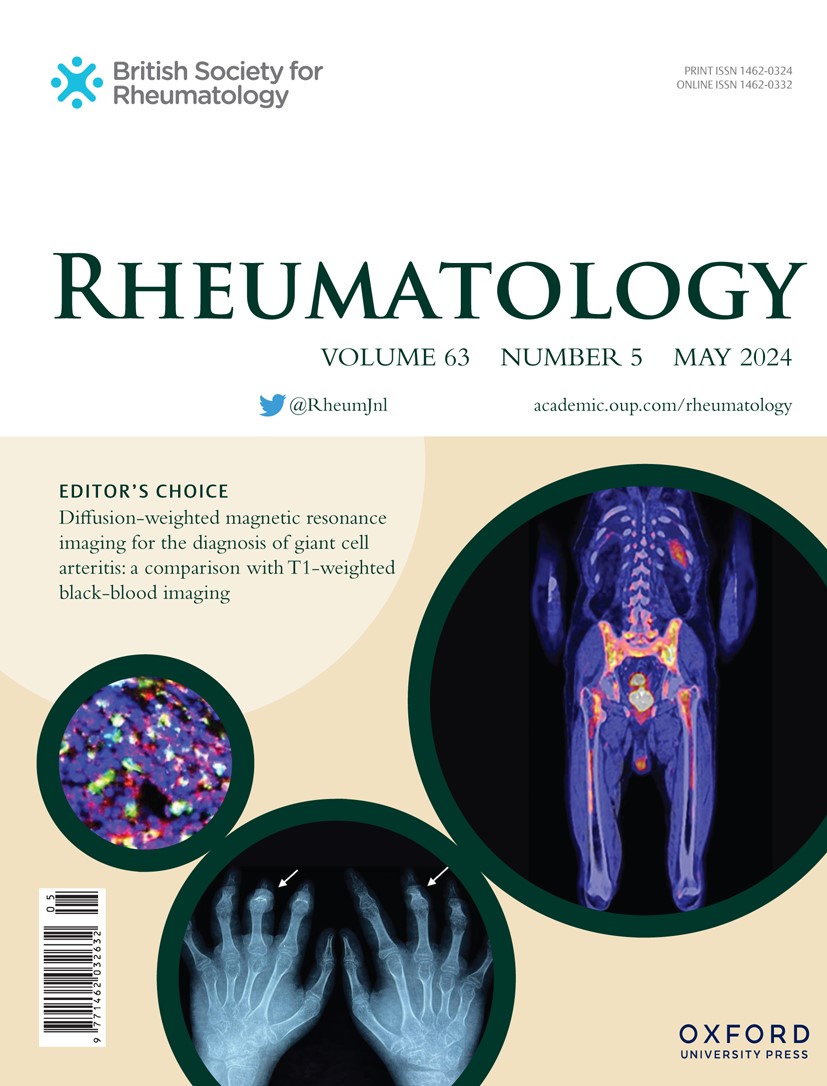Higher comorbidities associated with less improvement in disease activity in early rheumatoid arthritis: results from CATCH cohort.
IF 4.7
2区 医学
Q1 RHEUMATOLOGY
引用次数: 0
Abstract
OBJECTIVES Comorbidities negatively influence remission rates in rheumatoid arthritis (RA). This study estimated the effects of comorbidities on components of disease activity in early RA (ERA). METHODS Using the Rheumatic Disease Comorbidity Index (RDCI), the influence of comorbidities on trajectories of components of the SDAI (Simple Disease Activity Index) was assessed in participants with ERA enrolled in Canadian Early Arthritis Cohort (CATCH) over the first year of treatment. Adjusted effects of RDCI scores categorized 0, 1, 2, and ≥ 3 on SDAI trajectories over time were analyzed using multivariable generalized estimating equations (GEE) models adjusted for multiple confounders. RESULTS ERA participants (N = 2248) had a mean (SD) symptom duration of 5.7 (3) months; mean age 55 (15) years and 72% were female. Baseline SDAI was 29 (15), with 90% having moderate-high SDAI. Baseline RDCI scores were 0 in 888 (40%), 1 in 547 (24%), 2 in 451 (20%), and ≥3 in 362 (16%). While baseline disease activity was similar across comorbidity groups, patients with higher RDCI scores showed worse SDAI trajectories over the first year of RA treatment. Higher RDCI scores were independently associated with pain, patient and physician global assessments over time. CONCLUSION This large real-world analysis of ERA patients seen in routine rheumatology practice across Canada showed that while RA disease activity across comorbidity groups at diagnosis was similar, higher comorbidity was associated with slower improvement in RA disease activity over the first year of treatment, likely driven by independent associations with patient and physician global assessments and pain.目的:合并症对类风湿关节炎(RA)的缓解率有负面影响。本研究估计了合并症对早期RA (ERA)疾病活动成分的影响。方法采用风湿病共病指数(RDCI),在加拿大早期关节炎队列(CATCH)的ERA患者中评估合并症对SDAI(简单疾病活动指数)组成部分轨迹的影响。使用多变量广义估计方程(GEE)模型对多个混杂因素进行调整,分析了RDCI评分0、1、2和≥3对SDAI轨迹随时间的调整效应。结果2248名参与者的平均症状持续时间(SD)为5.7(3)个月;平均年龄55(15)岁,72%为女性。基线SDAI为29(15),其中90%为中高SDAI。基线RDCI评分为:888例(40%)为0分,547例(24%)为1分,451例(20%)为2分,362例(16%)≥3分。虽然共病组的基线疾病活动度相似,但RDCI评分较高的患者在RA治疗的第一年表现出更差的SDAI轨迹。随着时间的推移,较高的RDCI评分与疼痛、患者和医生的整体评估独立相关。结论:这项对加拿大常规风湿病实践中ERA患者的大型现实世界分析表明,虽然诊断时合并症组的RA疾病活动性相似,但在治疗的第一年,合并症越高,RA疾病活动性改善越慢,可能与患者和医生的整体评估和疼痛独立相关。
本文章由计算机程序翻译,如有差异,请以英文原文为准。
求助全文
约1分钟内获得全文
求助全文
来源期刊

Rheumatology
医学-风湿病学
CiteScore
9.40
自引率
7.30%
发文量
1091
审稿时长
2 months
期刊介绍:
Rheumatology strives to support research and discovery by publishing the highest quality original scientific papers with a focus on basic, clinical and translational research. The journal’s subject areas cover a wide range of paediatric and adult rheumatological conditions from an international perspective. It is an official journal of the British Society for Rheumatology, published by Oxford University Press.
Rheumatology publishes original articles, reviews, editorials, guidelines, concise reports, meta-analyses, original case reports, clinical vignettes, letters and matters arising from published material. The journal takes pride in serving the global rheumatology community, with a focus on high societal impact in the form of podcasts, videos and extended social media presence, and utilizing metrics such as Altmetric. Keep up to date by following the journal on Twitter @RheumJnl.
 求助内容:
求助内容: 应助结果提醒方式:
应助结果提醒方式:


